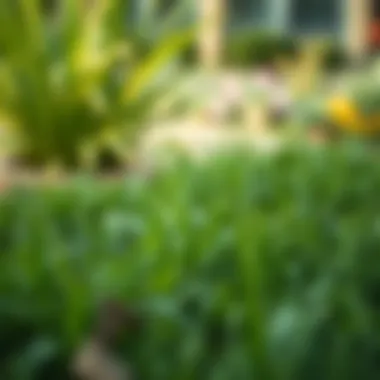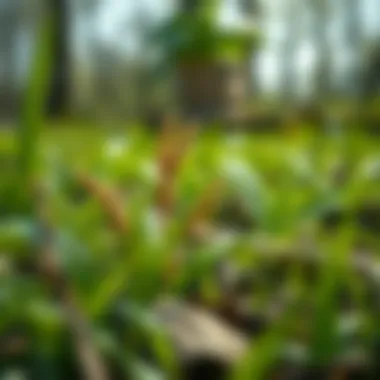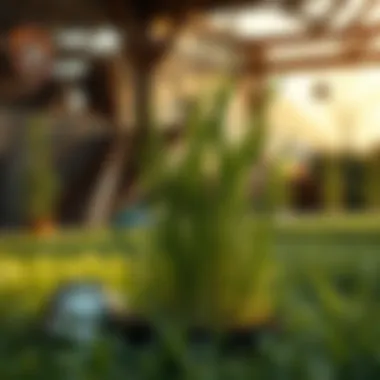Effective Strategies to Stop Grass Growth Naturally


Intro
When it comes to maintaining a magnificent garden or yard, controlling grass growth is crucial. Grass may seem harmless, but it can quickly morph into a rampant adversary, choking out the more delicate plants you cherish. Homeowners and garden enthusiasts alike are constantly on the lookout for effective methods to manage grass in various settings. This article will provide a myriad of strategies tailored for both residential and commercial properties.
Understanding the nuances behind why grass grows can make a world of difference in how you approach your garden. Is it the rich soil? The frequent watering? Or maybe the local climate plays a more significant role than you think? This exploration is essential for anyone keen on maintaining environmental integrity while keeping grass in check.
From chemical solutions that deliver immediate results to natural remedies that protect the ecosystem, you will find information tailored to your unique preferences throughout this guide. Whether you’re a gardening novice or a seasoned professional, our goal is to provide insights that empower your gardening decisions without compromising the overall health of your outdoor space.
With a diverse range of strategies at hand, let’s delve deeper into the topic and explore the various methods available to halt grass growth effectively.
Understanding Grass Growth
Understanding how grass grows is critical for anyone looking to manage their outdoor spaces effectively. This knowledge allows homeowners, landscaping professionals, and garden enthusiasts alike to take informed actions based on the growth patterns and challenges presented by grass. Grasping the basic biology behind grass not only empowers individuals to control it better but also helps in making decisions that can lead to a healthier yard or garden.
The Biology of Grass
At its core, grass is a resilient plant that plays a vital role in the ecosystem. Grasses belong to the Poaceae family and consist of many species, each adapted to various environments. Their growth starts from a series of structures known as tillers which arise from the plant base. Each tiller can grow a new leaf blade, and with the right conditions, they spread to form more densely packed areas.
One fascinating fact about grass is its ability to photosynthesize efficiently, allowing it to grow even in less-than-optimal conditions. Grass blades capture sunlight and convert it into energy, supporting its growth. In their natural habitat, grasses often thrive in well-drained soils, where they compete with other plants for resources. This competitive nature can be a double-edged sword; while it allows grass to flourish, it can also encroach on the territory of other desirable plants in gardens and landscapes.
The growth process of grass can be divided into stages: germination, seedlings, vegetative growth, flowering, and seed production. Each stage has its unique requirements for soil moisture and nutrients. For instance, young seedlings are particularly vulnerable to drought, highlighting the necessity of water management in fostering grass growth.
Factors Influencing Grass Growth
Numerous factors can affect how grass grows, and understanding these can lead to more effective control strategies. The most significant ones include:
- Soil Quality: The pH and nutrient levels in soil greatly influence grass health. For robust growth, the soil must be well aerated and rich in nutrients, particularly nitrogen, phosphorus, and potassium.
- Water Availability: Adequate moisture is key. Grass typically requires about one inch of water per week to establish healthy roots, especially during hot months.
- Light Exposure: Grasses generally need full sun to thrive. Shaded areas can hinder their growth significantly. Different species can tolerate varying levels, but excessive shade typically leads to grass decline.
- Temperature: Grass varieties are often categorized as cool-season or warm-season types, each thriving in different temperature ranges. Knowing which type you have can guide maintenance and management practices.
- Competition: Other plants, weeds, and even pests can compete with grass for nutrients, water, and light.
Understanding these factors is not merely academic; it’s practical. When homeowners recognize what promotes grass growth, they can make informed choices, whether they choose to control it through chemical means or prefer more natural approaches. This foundational knowledge helps in developing an effective strategy tailored to the specific conditions of their spaces.
"Understanding grass growth goes beyond simple observation; it's about strategizing effectively for a balanced relationship with nature."
In summary, the study of grass biology and the myriad factors affecting its growth is essential. A robust understanding equips individuals with the tools they need to achieve a beautiful, manageable landscape that aligns with their aesthetic desires and ecological goals.
Common Reasons for Controlling Grass
Controlling grass growth can stir up a multitude of conversations, from backyard barbecues to professional landscaping consultations. The reasons for wanting to manage grass can be as varied as the people seeking solutions. It's essential to recognize such motivations, as they essentially shape the strategies you might employ. Whether it’s purely aesthetic desires, practical landscaping purposes, or serious ecological concerns, each facet plays a vital role in spurring action against unruly grass. Let’s explore these underlying motives more closely.
Aesthetic Preferences
Right off the bat, many folks look to curb grass growth merely to elevate the visual allure of their yards. An overgrown yard can turn an otherwise charming property into something resembling a jungle, which is hardly what you want when hosting a gathering or even just enjoying a quiet afternoon outside.
A clean, well-maintained appearance not only boosts your satisfaction but also adds to curb appeal—an aspect that any homeowner should value. A vibrant and well-manicured landscape can be seen as a status symbol or a point of pride. One might imagine friends and neighbors casting glances filled with admiration at a beautifully arranged garden, contrasting sharply with wild patches of grass. Keeping grass growth in check allows for other features, like flower beds or ornamental shrubs, to shine and capture attention.
Landscaping Considerations
Landscaping is an art and science where every brushstroke matters. From enhancing property value to establishing outdoor sustainability, the importance of managing grass cannot be overstated. Grass, while often regarded as a filler or background, can consume substantial space and resources. Overgrown grass may mean less room for necessary plants or installations, such as walkways or seating areas.
Moreover, controlling grass means developing a functional outdoor space. Imagine designing a backyard oasis, only to discover that thick grass overpowers lounging areas.
- Creating focal points with unique plants can be overshadowed by stubborn grass.
- Effective management can lead to more vibrant social spaces and active outdoor lifestyles.
Also, there’s the added layer of maintenance. Mowing every week can feel like a chore, leaving little time for enjoying outdoor spaces.
Ecological Factors
Beyond the cosmetics and aesthetics, there are genuine ecological principles at play when considering grass control. This often involves broader environmental implications, such as water usage and biodiversity.
- Resource Consumption: Grass, particularly when well-watered, can consume an exorbitant amount of water, impacting local ecology. This is especially crucial in drought-stricken regions.
- Biodiversity Enhancement: Stopping stubborn grass growth can promote native species, encouraging broader biodiversity. Replacing grass with native plants can decrease the use of chemical fertilizers and pesticides, as those plants are adapted to local conditions.


As a responsible steward of your land, it's crucial to understand how grass control aligns with ecological well-being. It’s about weaving a landscape that thrives not just for you, but for your surroundings as well.
In summary, determining reasons for controlling grass growth is a multi-layered endeavor. Whether out of aesthetic desires, landscaping practicality, or ecological necessity, each driving force requires thoughtful strategies tailored to meet specific needs.
Chemical Approaches to Stop Grass Growth
Chemical approaches play a pivotal role in managing unwanted grass growth, providing quick and effective solutions for homeowners and landscaping services alike. Unlike natural methods which often require patience and consistency, chemical interventions can yield immediate results. That being said, incorporating a chemical strategy into grass control isn’t just about grabbing the nearest herbicide off the shelf; it involves understanding the nuances of these substances, their implications for the environment, and the best practices to utilize them effectively.
Herbicides, the primary chemicals used for grass control, vary widely in their formulations and functionalities. Knowing what you’re dealing with allows one to make informed choices that both address the problem of invasive grasses while safeguarding the vitality of desired plants and ecosystems.
Herbicides: An Overview
In simplest terms, herbicides are chemicals designed to kill or inhibit the growth of plants. There are two main categories: selective and non-selective.
Selective herbicides target specific types of plants, making them highly effective for controlling unwanted grasses in gardens while leaving desired flora unscathed. For example, products containing glyphosate can effectively manage broadleaf weeds, fostering the growth of grass and ornamentals simultaneously.
Non-selective herbicides, on the other hand, wipe out anything green within their reach. A product like Roundup fits this category, which can clear out sections of an overgrown yard, but must be used with caution as it can damage surrounding flora.
"Choosing the right herbicide is like picking the right tool for the job; you're only as good as what you use. Choose wisely."
Selective vs. Non-selective Herbicides
When grappling with grass issues, understanding the differences between selective and non-selective herbicides is crucial.
- Selective Herbicides
- Non-selective Herbicides
- Targeted Action: These chemicals act on specific grass types without harming surrounding plants. For instance, a selective herbicide containing clopyralid might effectively eliminate Canada thistle while preserving neighboring flowers.
- Application Timing: Generally, they show the best results when applied during specific growth stages, usually when the grass is actively growing. This makes timing essential.
- Residual Effects: The benefits of using selective herbicides include a reduced risk of environmental damage, which is particularly important if you have a diverse garden.
- Broad Coverage: These can kill any plant they come in contact with. This makes them useful for clearing an area completely, but caution is necessary, especially in desirable spaces.
- Quick Results: Non-selective herbicides often work fast, as great for immediate needs, but can decimate entire ecosystems if not applied carefully.
- Soil Impact: Users should be aware that these chemicals can remain in the soil, potentially affecting future plant growth for extended periods after application.
Safe Application Techniques
Using herbicides comes with responsibility. Here are some practical techniques to ensure safe application:
- Read Labels Carefully: Every product comes with guidelines on how to use it safely. Failure to follow these instructions can lead to unintended damage.
- Wear Protective Gear: Gloves, goggles, and masks can protect your skin, eyes, and lungs from exposure during application.
- Select Appropriate Weather: Avoid applying on windy days to prevent drift into unintended areas. Rain can wash away the effectiveness if it occurs soon after application.
- Target Application: Using spray bottles or shields can help contain the herbicide to the intended area, minimizing collateral damage.
- Follow-up Treatments: Just because you’ve applied doesn’t mean you’re done. Assess the area after a few weeks for any regrowth and address accordingly.
By employing these methods, you ensure safe practices while achieving desired results, contributing to an overall balanced approach to grass management.
Natural Methods for Grass Control
The pursuit of keeping grass growth in check often leads individuals to consider various methods. Among them, natural methods represent a solid solution. They cater not only to the desire for control but also for sustainability. Homeowners and gardening enthusiasts are increasingly drawn to these approaches because they can curtail grass without posing a threat to the environment. For many, this means choosing strategies that are safe for pets, children, and nearby wildlife. Furthermore, the beauty of natural methods is that they enhance soil health and promote biodiversity.
Natural approaches to grass control often involve techniques that work in harmony with nature rather than against it. Emphasizing practices like mulching, fostering plant competition, and leveraging soil amendments allows for effective grass management that aligns with eco-friendly principles.
Mulching Techniques
Mulching is one of the simplest and most effective methods to control grass growth. By laying down a thick layer of organic or inorganic material over the soil, you create a barrier that suppresses grass and other unwanted weeds. The benefits of mulching are myriad: it conserves soil moisture, moderates soil temperature, and even enriches the soil as it decomposes. There's also an aesthetic appeal; a well-mulched garden or yard can look tidy and well-cared-for.
Here are some effective mulching materials:
- Wood chips: These are great for pathways and flower beds.
- Straw or hay: Efficient for vegetable gardens.
- Grass clippings: A quick way to recycle yard waste while blocking grass growth.
When applying mulch, ensure it’s at least two to four inches thick to block out light effectively, which grass needs to grow. However, be cautious not to pile mulch too close to the stems of plants, as this can cause rot.
Plant Competition
Introducing plants that naturally outcompete grass is another strategy. Choose species that thrive in conditions where grass tends to flourish, such as moisture-rich environments or nutrient-dense soils. For example, planting flower or vegetable varieties that spread quickly can limit grass encroachment. Beyond the practicality of this method, it can also create a vibrant ecosystem that attracts beneficial insects, enhances pollination, and boosts overall garden vitality.
Consider these competitor plants:


- Clover: Not only does it suppress grass, but it also enriches the soil with nitrogen.
- Violets: They spread rapidly, providing shade that discourages grass growth.
- Mint or Thyme: Both are hardy ground covers that thrive in various conditions.
By diversifying your planting strategy and encouraging a competitive environment, you can effectively reduce grass growth while adding beauty and interest to your landscape.
Soil Amendments
The foundation of any successful gardening endeavor lies in its soil. Adjusting soil quality can be a game changer in grass management. When you enrich your soil with organic matter or relevant nutrients, you create an environment that is less favorable for grass. For instance, acidic soils may discourage grass growth, while adding lime can change pH levels to favor your desired flora over grass.
Some useful soil amendments include:
- Compost: Adds nutrients and improves soil structure.
- Mulched leaves: Slow-release organic matter that can enhance soil fertility.
- Sand: Aids in drainage, making the soil less conducive for grass to take root.
Finale
Utilizing natural methods for grass control not only addresses the need to manage grass in gardens and yards, but also promotes environmental health and beauty. By employing strategies like mulching, introducing plant competition, and enhancing soil quality, homeowners can achieve their goals in a sustainable, effective manner. These approaches offer a holistic view that aligns well with the values of modern gardening and landscape practices.
Mechanical Control Methods
Mechanical control methods are essential in the realm of grass growth management. These techniques touch on physically manipulating grass, offering a direct approach to control its proliferation. They come with their respective advantages and limitations, but when executed correctly, mechanical methods can yield significant benefits for homeowners and gardening aficionados alike. Utilizing mechanical means can be both environmentally conscious and cost-effective, providing solutions that align with immediate geographic and climatic conditions.
Mowing Practices
Mowing is probably the most widespread mechanical control method utilized in the fight against unwanted grass growth. Regular mowing serves multiple purposes; it prevents grasses from flowering, limits seed spread, and encourages a health with the remaining plants. However, the effectiveness hinges not just on frequency but also on technique.
Benefits and Considerations:
- Height Matters: Cutting grass too short can weaken it, making it vulnerable. Aim to mow at a height of about three inches, promoting healthier growth for the remaining plants while stunting grass.
- Timing is Crucial: Mow during dry conditions. Wet grass can lead to clumping and uneven trimming, creating hiding spots for pests.
- Frequency: In the growing season, it’s advisable to mow at least once a week. In contrast, reduce frequency during the colder months.
- Sharp Blades: Ensure your mower blades are sharp. Dull blades can tear instead of cut, stressing the plants and leaving them open to disease.
Investing time to understand the mowing specifics can markedly enhance control efforts.
Tilling Techniques
Tilling presents another mechanical approach to address grass growth, especially in areas where grass has taken over garden plots or unmanageable spaces. This method involves turning over the soil to disrupt root systems, effectively curtailing unwanted grass.
Insights on Tilling:
- Deep Tillage: Going down about 6-8 inches is advisable for effective root disruption. This technique also aerates the soil, allowing for improved nutrient absorption.
- Timing is Key: The best time for tilling is post-rainfall or when the soil is damp, making for easier maneuverability. Avoid heavy tilling during hot dry spells to prevent soil compaction.
- Incorporating Organic Matter: Adding compost or mulch during tilling can bolster soil quality while simultaneously suppressing grass growth by blocking light.
While tilling can be labor-intensive, the outcomes are often worth the effort, particularly when re-establishing native flora or a new planting scheme.
Using Ground Covers
Utilizing ground covers is a method of mechanical control that promotes desired plant species while suppressing grass growth. Ground covers, such as clover or creeping thyme, create a dense mat that prevents sunlight from getting to the grass and significantly reduces its chance for survival.
Advantages of Ground Cover:
- Natural Barrier: These plants can choke out grass by competing for resources like light, water, and nutrients.
- Minimized Maintenance: Once established, ground covers require less upkeep and will maintain their vigor with minimal human intervention.
- Ecological Benefits: Many ground covers attract pollinators and beneficial insects, enhancing the garden ecosystem rather than degrading it.
When selecting ground covers, it’s important to consider local climate conditions, soil composition, and the foot traffic the area receives. Thus, choosing the right varieties can create a sustainable balance between aesthetics and practicality.
"Mechanical methods might seem straightforward, but they can profoundly impact the lifespan and health of your garden if not approached with care."
By implementing these mechanical control methods mindfully, homeowners can take significant strides toward managing grass growth effectively.
Understanding that there’s no one-size-fits-all solution is key. Assessing the site and conditions, along with ongoing education on proper techniques, can enhance outcomes and ensure a thriving landscape.
Preventative Measures to Reduce Grass Growth
Preventing grass growth is not just about exterminating the greens once they appear; it’s about taking strategic steps beforehand. Preventative measures are essential for anyone aiming to create a garden or lawn that doesn’t become inundated with grass. Why is this significant? With a little foresight and planning, you can save yourself from a battle that rears its head time and again.
Site Selection and Preparation


Choosing the right spot for your garden plays a pivotal role in determining how well you can manage grass growth. Sites that are overly fertile or that receive plenty of sunlight can be prime breeding grounds for grass. If you find yourself with a piece of land that has soil rich in nutrients and full sun exposure, it may become a hotbed for vigorous grass that can overpower your desired plants.
- Evaluate Soil Quality: Check the pH and nutrient levels in your soil.
- Assess Sunlight: Observe how much sun the area gets throughout the day.
- Choose the Right Location: If possible, select shaded or less fertile areas for more delicate plants. Grass thrives in bright, nutrient-laden areas, so planting in slightly suboptimal conditions can keep grass at bay.
Ensuring proper preparation of the selected site is equally important. This includes weeding thoroughly before you plant anything. Removing existing grass or any unwanted weeds will create a clear slate. Turning the soil can help to disrupt any grass root systems that may linger.
Water Management Strategies
Water is a blessing, but it can also be a curse when it comes to grass control. Grass loves water, and the more moisture in soil, the easier it is for it to grow. Therefore, managing how much water is available to unwanted grass is paramount.
- Irrigation Scheduling: Implementing a timed irrigation system can help. Make sure to water plants in the early hours of the morning or late in the evening to avoid evaporation and discourage grass growth.
- Utilizing Drip Irrigation: This method allows water to drip slowly to the roots – keeping your main plants nourished but lessening the amount of water available for grasses.
- Rainwater Collection: Consider setting up rain barrels to capture and use rainwater for your plants, reducing the overall moisture levels in soil that may favor grass growth.
"In the battle against unwanted grass, a little change in water management can save you future headaches."
Planting Non-Grass Flora
Finally, consider integrating various plants that don’t belong to the grass family into your landscape plan. When you populate your area with diverse flora, you actively compete against grass for resources, making it harder for grass to establish itself, let alone thrive.
- Choose Ground-Cover Plants: Using hardy ground covers like creeping thyme or clover can help occupy space and limit grass growth.
- Incorporate Perennials: These can be beneficial as they typically have deeper roots, competing more effectively for nutrients and water.
- Colorful Flora: Mixing in flowering plants will not only contribute to visual appeal but also further create a competitive environment for grass.
Good site preparation, water management, and careful selection of flora are foundational elements that can greatly diminish the odds of grass outpacing your garden designs. Not only do these methods save a lot of hard work in the long run, but they also align with ecological gardens, offering diverse benefits to the surrounding environment.
Assessing the Impact of Grass Control Strategies
When looking at the whole picture of controlling grass growth, evaluation is paramount. Understanding the impact of various strategies—be it chemical, natural, or mechanical—can guide homeowners and gardening enthusiasts in making informed decisions. This section dives into the outcomes of grass control methods, emphasizing the necessity of an ongoing assessment rather than a one-off fix.
Short-term Results
Short-term results often provide the first glimpse of success or failure in grass control efforts. When immediate results are visible, homeowners may feel encouraged. But it’s essential to recognize that temporary fixes can sometimes lead to long-term challenges.
Consider this:
- Usage of Herbicides: Initially, a herbicide application can effectively reduce grass growth, but its efficacy over time can wane. Some grass types may become resistant, leading to the necessity for stronger chemicals, which can create a cycle of dependency.
- Mechanical Solutions: Techniques like mowing or tilling may yield quick results. However, if not managed properly, these methods might disrupt soil structure or encourage new grass growth in the subsequent seasons.
- Natural Methods: Mulching can curb grass for a while, but one must monitor the mulch's breakdown and its impact on the soil's nutrient dynamics.
The idea to focus on here is that while you may achieve a quick win, without a holistic view of future repercussions, you might be setting yourself up for a greater hassle down the line. As they say, “A stitch in time saves nine.”
Long-term Environmental Effects
Long-term implications often overshadow the immediate benefits of grass control strategies. A thoughtful consideration of these environmental outcomes can serve both ecological and personal interests.
- Soil Health: Persistent use of chemicals can lead to soil degradation, affecting its microbial composition. This is crucial because healthy soil promotes not just grass control, but overall ecosystem balance. To protect this delicate system, consider integrating soil amendments or even exploring planting companion species as a complementary approach.
- Biodiversity Considerations: Using non-selective herbicides may impact not only the targeted grass but also surrounding flora and fauna. For instance, pesticides could limit the diversity of beneficial insects such as pollinators which are vital for a thriving garden.
- Water Quality: Runoff from chemical applications can contaminate local waterways, affecting aquatic life and drinking water. Engaging in more sustainable practices is not just a personal win; it promotes community health and environmental responsibility.
“Taking a long view can help avoid pitfalls that many gardeners encounter when they focus solely on short-term aesthetics.”
In summary, while short-term results provide an instant sense of achievement, the focus must also trail towards sustenance over time. Balancing quick fixes with an eye on ecological ramifications ensures a more harmonious living environment. Thus, vigilance and assessment shouldn't be an afterthought but woven into the fabric of your grass control strategy. By paying attention to both immediate results and long-term impacts, you can cultivate a landscape that thrives today and stands the test of time tomorrow.
The End and Future Considerations
Cutting to the heart of the matter, recognizing the importance of grass control is paramount for anyone looking to maintain a pristine home or commercial environment. This article has taken readers through a comprehensive journey, examining every nook and cranny of grass growth and the methods to manage it. As the final chapter unfolds, it's clear that controlling grass isn’t just about pulling weeds or spraying an herbicide—it’s about implementing a strategy that resonates with each person's unique needs and the broader ecological context.
Evaluating Effectiveness
In evaluating the effectiveness of grass control strategies, it is crucial to establish measurable criteria. Many homeowners may take a trial-and-error approach, but having specific goals can help streamline the process significantly. For instance, monitoring grass density before and after intervention can provide solid data on what works and what’s just wishful thinking. Here are some methods to evaluate effectiveness:
- Visual Assessment: Regularly walking through the area to observe changes. A discerning eye is often the first line of evaluation.
- Soil Testing: Checking nutrient levels before and after measures can highlight improvements in soil health, which could correlate with reduced grass growth.
- Time Tracking: By documenting how long it takes for grass to regrow after applying different methods, homeowners can pinpoint the most effective strategies.
Engaging with local gardening groups can also provide insights and anecdotal evidence about what has worked for others in similar environments. Always remember, what is effective in one location may not yield the same results in another due to varying soil types and local climate conditions.
Innovative Approaches on the Horizon
Looking forward, several innovative strategies are emerging that promise to revolutionize the way we control grass growth. For instance, developments in biotechnology are leading to the creation of targeted herbicides that more effectively differentiate between desirable plants and aggressive grass species. Additionally, the concept of integrated pest management (IPM) is gaining traction in the gardening community, where biological, chemical, and cultural practices work in tandem. Here are a few notable innovations:
- Biodegradable Barriers: New materials that can be placed over soil to block light and inhibit grass growth without the use of chemicals.
- Smart Irrigation Systems: Tech-infused sprinklers that adjust watering based on the soil moisture level can prevent over-saturation, which often leads to robust grass growth.
- Precision Agriculture Technologies: These tools help landowners apply solutions more efficiently, reducing waste, and allowing for more targeted intervention.
"The future of grass management lies not just in controlling its growth but in understanding our role in the ecosystem."
In summary, controlling grass growth is an evolving field that combines the wisdom of traditional methods with cutting-edge technological advancements. With a solid understanding of grass biology and suitable strategies tailored to personal preferences, it's entirely possible to create spaces that are visually appealing and ecologically sound. For more information, check out resources from Wikipedia, Britannica, and gardening forums on Reddit that discuss effective strategies and innovative solutions.







